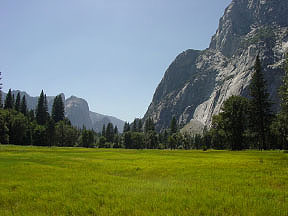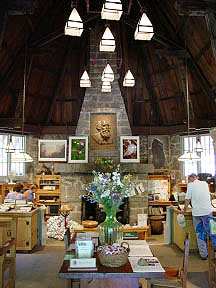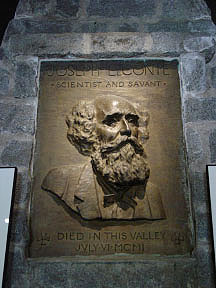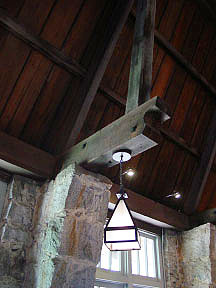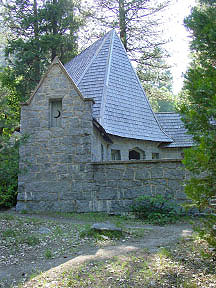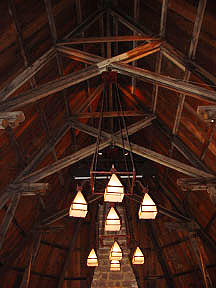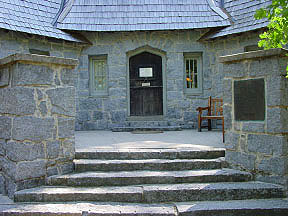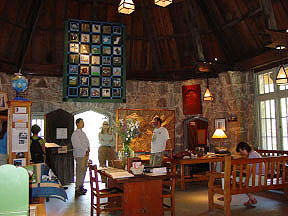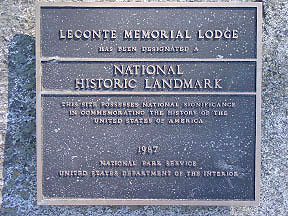Le Conte Memorial Lodge
Steven Finacom
18 June 2005
Yosemite Valley (photo: Steven Finacom, July 2004)
Le Conte Memorial Lodge (photo: Steven Finacom, June 2005)
On Thursday, 12 May 2005, BAHA hosted the second of its Sierra speakers in the Hidden Lodges of Berkeley and Beyond lecture series. Dr. Bonnie Johanna Gisel came to Berkeley from Yosemite to talk about the Le Conte family and the historic Le Conte Memorial Lodge in Yosemite Valley, where she serves as curator.
Gisel, a naturalist, writer, and scholar, lives in a Yosemite Valley campsite for several months each year and directs a corps of volunteers who staff the Le Conte Lodge, opened in 1904, as an education center and memorial to the eminent University of California Professor Joseph Le Conte (1823–1901).
Photo: Steven Finacom, June 2005
Le Conte Lodge interior (photo: Steven Finacom, July 2004)
Curator Bonnie Gisel (photo: Steven Finacom, June 2005)Joseph Le Conte was an avid Yosemite visitor, friend of John Muir, and one of the founders of the Sierra Club. After he died during a visit to Yosemite Valley in 1901, his friends and family donated funds to construct the Lodge. It was the first permanent visitor center in Yosemite. The Lodge is currently owned by the National Park Service and operated by the Sierra Club; some 15,000 people a year visit during the summer months.
Bas-relief by Douglas Tilden (photo: Steven Finacom, July 2004)
The beam recalls Maybeck’s style (photo: Steven Finacom, July 2004)The building, built of stone and timber, with a dramatic peaked roof, is recorded as designed by John White, Maybeck’s brother-in-law. During her talk, Gisel presented a case for its being an authentic Maybeck design. The building originally stood in Curry Village, at the base of Glacier Point; it was moved to its current location, across a road from Yosemite’s Housekeeping Camp, in 1919.
Side view of the steep roof (photo: Steven Finacom, June 2005)
Roof trusses � la Maybeck (photo: Steven Finacom, July 2004)Gisel spoke in Senior Hall on the U.C. Berkeley campus to a full room of BAHA lecture audience. She vividly described the mission and heritage of the unique Le Conte Lodge building, and the importance of maintaining it as an educational center and force both within the Sierra Club and for the general public. Like most of the other buildings profiled in the Hidden Lodges series, the Le Conte Memorial Lodge is now more than a century old but still serves the purposes envisioned by its creators.
Gisel’s illustrated talk described not only the history and design of the Lodge but also the story of the Le Conte family, going back to the Georgia rice plantation where Joseph Le Conte and his brother John grew up. Displaced from the South by the Civil War, they eventually came to Berkeley and began new careers on the faculty of the new University of California.
Front entrance (photo: Steven Finacom, June 2005)
Front entrance, interior (photo: Steven Finacom, July 2004)
Photo: Steven Finacom, June 2005The first installment of the Hidden Lodges of Berkeley and Beyond lecture series was organized by BAHA Board members Jane Edginton and Steven Finacom, and co-sponsored by the Order of the Golden Bear and The Faculty Club at the University of California, Berkeley. The five-lecture sequence, from February to June 2005, explored the history and heritage of several buildings built in a rustic style in the late 19th or early 20th centuries in Berkeley or in places Berkeleyans enjoyed visiting, including Yosemite, Lake Tahoe, and elsewhere in the High Sierra.
Photos & text © 2005 Steven Finacom.
Additional reading:
The Sierra Club’s Le Conte Memorial Lodge website.
Drawing of the proposed Le Conte Memorial Lodge in the The Autobiography of Joseph Le Conte, published posthumously in 1903.
The digital edition of A Journal of Ramblings through the High Sierras of California by Joseph Le Conte is a detailed account of Le Conte’s first trip to Yosemite in the summer of 1870. This text is part of the Library of Congress online archive The Evolution of the Conservation Movement, 1850–1920.
The digital edition of The Autobiography of Joseph Le Conte contains several shorter accounts of Le Conte’s visits to Yosemite:
In the summer of the same year [1870], at the end of the first session of the University, eight of the students invited Professor Frank Soul�, Jr., and me to join them in a camping trip to the Sierras, and we joyfully accepted. This trip was almost an era in my life. We were gone six weeks and visited the Yosemite, the high Sierra, Lake Mono and the volcanoes in the vicinity, and Lake Tahoe. The trip was made in the roughest style of camp life, each man carrying his bedding and extra clothing in a roll behind his saddle, and a packhorse bearing the food and camp utensils for the party. We had no tent, but slept under trees with only the sky above us. I never enjoyed anything else so much in my life—perfect health, the merry party of young men, the glorious scenery, and, above all, the magnificent opportunity for studying mountain origin and structure. Observations made on this and later trips formed the basis for ten or eleven papers on this most fundamental and fascinating subject and on others closely related. I subsequently made many similar trips, but this remained the most delightful, because, as it was the first, everything was so new to me and so different from anything that I had previously experienced. I do not attempt to describe it in detail, because my observations, jotted down from day to day at our noon camps, were published, in 1875, as A Journal of Ramblings through the High Sierras of California by the University Excursion Party, and, the original edition being out of print and scarce, reprinted by the Sierra Club in 1900. [...]
In the summer of 1878 I took my usual relaxation by a camping trip to the Yosemite, but as this time my wife and children accompanied me that they too might enjoy camp life in the presence of the grand scenery of the valley, we traveled much more comfortably than I usually did. Including a girl friend of my daughter’s, Captain Greenough, then Commandant of the University Cadets, Mr. Charles Butters, a student who acted as driver, and our Chinese cook, our party numbered eight. Captain Greenough and I rode horseback and the rest of the party traveled in a fine wagon made expressly for camping. We were gone five weeks and visited the Calaveras grove of Big Trees in addition to the Yosemite. [...]
In the summer of 1882 we again made a camping trip to the Yosemite, partly for the benefit of my daughter Emma and my cousin Jack Le Conte, who had come to us from the East broken down in health. Our party numbered eight, of whom seven went in a coach-and-four that we hired, while Professor O’Neill, of the department of chemistry of the University, rode on horseback. We camped all the way to the valley and back, and the six weeks in the open air did the invalids a great deal of good. My daughter was in an ecstasy of delight all the time, the exhilarating mountain scenery and mountain air seeming to renew her youth in a wonderful way. Jack and his father, John L. Le Conte, who had accompanied him to California, enjoyed the trip greatly, and the life of the former was undoubtedly prolonged by it. For my own part, I think I enjoyed the valley more, if possible, on this trip than ever before. There are two kinds of enjoyment of scenery, as of everything else. The one is the enjoyment of beauty and grandeur, heightened by novelty; the other is the enjoyment of the same mellowed and hallowed by association. The one affects more the imagination, the other the heart. I had been in the Yosemite so often that I now loved it for its association with previous delights. [...]
The following summer [1889] I again went camping in the Sierras with a party of young men, of whom my son was one; and for the first time felt that I was losing my physical endurance. I was then sixty-six, and the long ride over the hot San Joaquin plains not only greatly fatigued me but utterly destroyed my appetite. It was not till we were well up in the mountains that my strength returned, but from that time on I was as strong as ever and enjoyed life as much as the youngest of the party. We went only over ground that was already familiar to me—Yosemite, Tuolumne Meadows, Mono Pass, Mono Lake, etc.—but I made the trip again partly for the love of camp life, partly that I might impart my love of nature to my pupils, and particularly to my son. He has since become the best camper and mountaineer I ever knew, tramping four or five hundred miles in the Sierras every summer and probably knowing them better than any other living man, unless possibly Mr. John Muir. He is, moreover, an extremely expert photographer; I have never seen anything equal to his photographs of the Yosemite and the High Sierra. [...]
In June [1893] I went on a camping trip to the Yosemite with my son. I was far from well, and did not improve in the valley. Over three-score and ten, I felt that my life was spent, and thought that surely this was the last time I should see the Yosemite. Ill and low-spirited, I rode about alone, taking leave with tears of the splendid cliffs and glorious waterfalls as of dearest friends. But as a matter of fact I visited the valley several times after this. [...]
The summer of 1897 I spent in the Yosemite once more with my family, my son and daughter camping and my wife and I staying at the hotel. I joined the campers for a while and made a very enjoyable trip of three or four days to Clouds’ Rest and the Little Yosemite. Is this the last time I shall behold these marvels, the very last? We shall see.
Joseph Le Conte passed away at the base of Glacier Point in Yosemite Valley on 5 July 1901. The editor of his autobiography, William Dallam Armes, provided an account of Le Conte’s final visit to Yosemite in the preface to that book, published posthumously in 1903.


